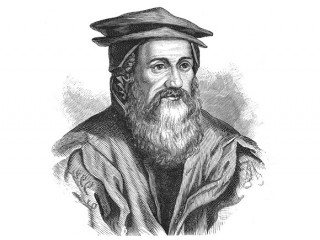
Konrad Von Gesner biography
Date of birth : 1516-03-26
Date of death : 1565-12-13
Birthplace : Zurich
Nationality : Swiss
Category : Science and Technology
Last modified : 2011-10-11
Credited as : naturalist, Historia animalium, pulmonary bubonic
The Swiss naturalist Konrad von Gesner (1516-1565) wrote "Historia animalium," which is considered the basis of modern zoology.
Konrad von Gesner was born on March 26, 1516, in Zurich. The man who was to become known as the German Pliny and to be ennobled by the Hapsburg emperor Ferdinand I began his life inauspiciously. His father, a poor furrier, perished in the battle of Kappel in 1531, as the wars spawned by the Reformation laid bloody hands on the Swiss cantons.
Young Gesner came under the protection of Heinrich Bullinger, Huldreich Zwingli's successor, and Oswald Myconius, the Protestant classics scholar. Their generosity permitted Gesner to undertake studies at the University of Strassburg, where he displayed great linguistic talent and interest in nature. Although he angered his guardians by marrying a beautiful but impoverished lady, Gesner was allowed to continue his studies at Basel, where he also studied medicine.
Gesner secured the professorship in Greek at Lausanne in 1537 and speedily compiled a dictionary in that language. The city physician of Zurich prevailed upon the young scholar to resume his medical studies so after wandering across France, Gesner settled down at the medical school of Montpellier and became a doctor of medicine. For his degree he successfully defended an anti-Aristotelian thesis on the nature of sensation.
Sometime after 1540 Gesner began teaching Aristotelian physics at the Collegium Carolinium. In his spare time he composed his Bibliotheca universalis, a vast encyclopedia in which he listed alphabetically all of the authors who had written in Greek, Latin, and Hebrew, with a listing of all their books printed up to that time. This work made Gesner famous, and offers of scholarly employment poured in, including one from the Fuggers, the richest family of Europe. The Fuggers, however, attached the condition that Gesner embrace Catholicism, which he refused. He spent the rest of his life as a practicing physician at Zurich, leaving only for short expeditions to study flora and fauna.
In 1551 Gesner began work on the most comprehensive survey of nature undertaken during the Renaissance epoch, his monumental Historia animalium, an illustrated encyclopedia of the entire domain of living creatures: birds, fish, and animals. The work was an improvement of earlier European efforts of this kind but reflected the transitional nature of Renaissance scientific thought. Though including descriptions of creatures from remote America, Asia, Russia, and Africa, Gesner also described a host of mythical beasts. Although he had used such taxonomic devices as "genus, species" and "class, order" in his description of plants, Gesner showed little advance over Aristotle in discerning a pattern of biological order, a task to be delayed for almost 2 centuries. His book was beautifully illustrated by artists of the time and included drawings by Albrecht Dürer.
In 1555 Gesner wrote a tome on his first love, languages, entitled Mithridates. In 1564 the emperor Ferdinand conferred the title of nobility on Gesner, who designed his coat of arms to portray the books he had written and those that he still planned, including one on nine classical authors and one on gems. In 1565 the plague, which has been identified from Gesner's description as a form of pulmonary bubonic, came to Zurich, and on December 13 he died. A true child of his turbulent times, Gesner was still enthralled by a semireligious vision of nature, a vision composed of an unstable mixture of Aristotle, Scripture, and a passionate desire to explore and observe nature directly and personally.
There is no biography of Gesner in English. Useful studies are Henry Morley, Clement Morot and Other Studies (2 vols., 1871; repr. 1970); Frank Dawson Adams, Birth and Development of the Geological Sciences (1938); and George Sarton, Six Wings: Men of Science in the Renaissance (1957).
Braun, Lucien, Conrad Gessner, Geneve: Editions Slatkine, 1990. □
















